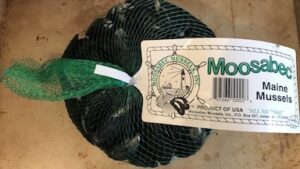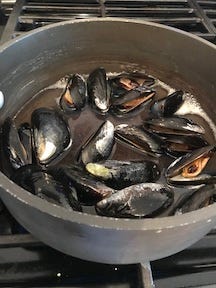Art Adventure • 09.01.2023
 I do not like mussels. I do not eat mussels. And I certainly do not cook mussels. (Or much of anything else, but that’s a story for another time.)
I do not like mussels. I do not eat mussels. And I certainly do not cook mussels. (Or much of anything else, but that’s a story for another time.)
Relying on Abby’s observation that some mussels are blue, and my research that indicated blue mussels grow in Maine, I was planning a road trip to the Gulf of Maine. But on reflection I thought that maybe a road trip to the grocery store would be more efficient.
I found Maine-sourced mussels at Whole Foods. The shells were a dark bluish-black, definitely more black than blue. I bought a bag (the fish people didn’t admit to having any spare shells hanging around out back), took them home and put them in the fridge while I researched how to cook them—steam them, all sources said. I know how to steam broccoli and figured the same principles would apply. They did.

The immediate challenge was that the shells were beginning to smell. A solution of 50/50 bleach and water would do the trick, YouTubers advised, but since it’s color I am concerned with, that ratio seemed too drastic. So I tried a bowl of lukewarm water with a tablespoon of bleach.

That seemed to improve the smell. I soaked all of the shells while I determined the best place to try to view August 30’s Blue Supermoon. There won’t be another until 2037, so I thought I shouldn’t miss the opportunity, just in case. Found the moon. Back home to the shells.
The shells, which had been soaking in the bleach water for almost an hour, smelled distinctly odd, so I washed them in water and dishwashing detergent, rinsed them, and dried them in the microwave. They were really quite pretty—almost a Payne’s Gray (ultramarine blue and black). I decided to bag them and put them in the fridge for the night just in case the odor was not completely gone.
I pulled the shells out of the fridge the next afternoon and they smelled like the beach, so I soaked them in a stronger bleach/water solution. As soon as I put a few in the bowl, the water became cloudy. I thought something must be dissolving, but I wasn’t sure what. I left a sample in the bowl for half an hour to make sure it wasn’t the shells.
BTW, speaking of smells, I have wondered what would happen if one mixed a fragrant oil with paint—say, lavender essential oil with a mauve oil paint. Since I may use this blue to paint seascapes, a beachy smell might work, though I don’t know how long it would last, or what it would do to the longevity of the paint. But given the substances that some of the Old Masters mixed into their paint, it could be worth a try.
I ended up soaking all of the shells in the stronger solution for about an hour. This turned

out to be a terrific decision. The shells turned distinctly blue!
The second bleaching had removed the black stuff on the outside of the shell. The periostracum, as the black stuff is officially called, is a thin, organic coating that protects the shell from corrosion, I discovered.
The shells were just lovely. It was time to take a hammer to them.
I had my safety goggles, a hammer, a stainless steel frying pan, and a piece of canvas. I guessed that the pulverized shells would be a lighter blue than the intact shells because I read somewhere that smaller particles have more surfaces that reflect more light. I hammered away.
Seashells
Here are my shells after about an hour of work with a mortar and pestle. Not nearly fine enough for pigment.